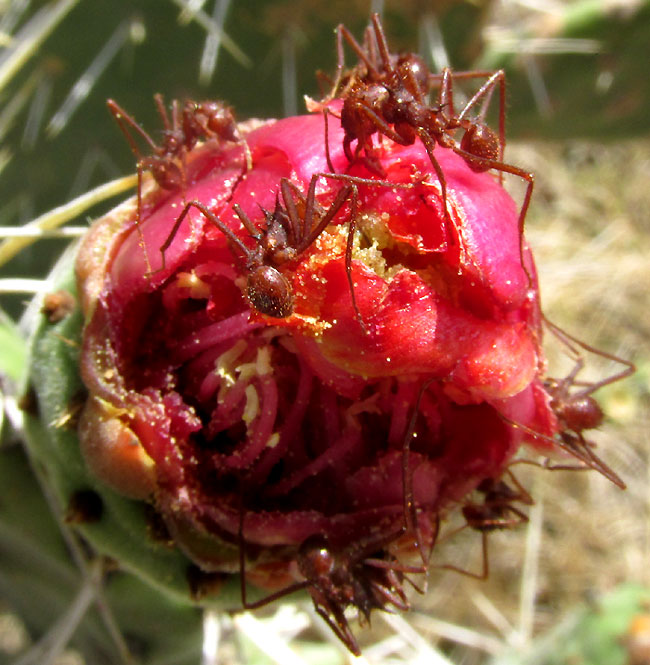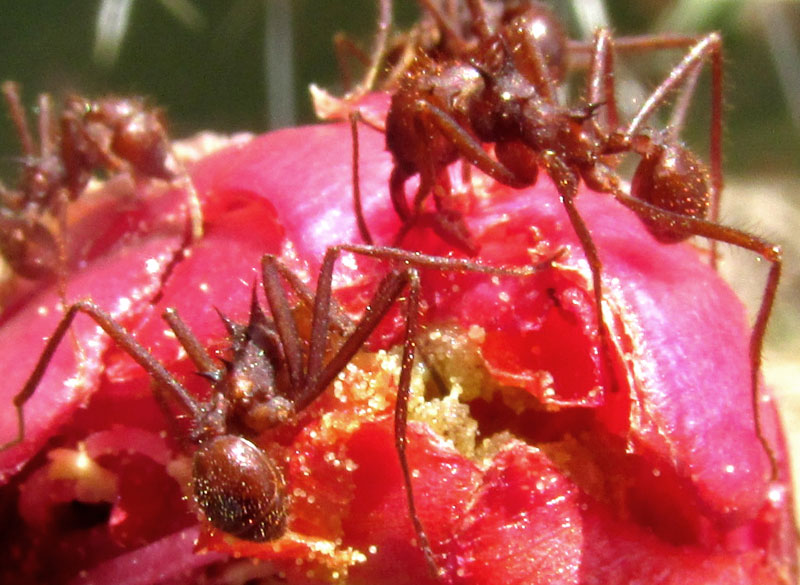entry dated April 12, 2023, issued from near Tequisquiapan, elevation about 1,900m (6200 ft), N20.565°, W99.890°, Querétaro state, MÉXICO
(~N20.55°, ~W99.89°)
MEXICAN LEAFCUTTER ANTS CUTTING UP CACTUS FLOWERS

Ants were busy cutting apart a flower of an Opuntia depressa pricklypear cactus. I'd read that numerous ant species feed on flowers or parts of them, and I wondered which ant species this was. Once the above picture was expanded onto my computer screen and the spines on the head and thorax of the large, reddish ant were seen, it was clear it was usual ravager of leaves and occasionally other plant parts in this area, ATTA MEXICANA, often called the Mexican Leafcutter in English, though sometimes they're more loftily named the Neotropical Giant Leafcutter. Here's a closer look at the ants:

As its GBIF Occurrence Map indicates, this is the common leafcutter ant in most of Mexico, south through Honduras, plus it appears to be advancing northward into hot, dry parts of the US Southwest.
As is the case with all leafcutter species, the ants seen above aren't eating the flower's parts, but rather will carry the parts to their underground nests, where a special fungus will grow on the parts, and the ants will feed on the fungus.
There's a fine Wikipedia Leafcutter page -- leafcutters being the genus Atta -- describing the enormous importance of leafcutter ants to tropical ecosystems.
Leafcutters ants in general, genus Atta, are recognized with their large size, rusty red or brown color, long legs and the spines visible in the above pictures. They produce no venom and don't sting, though they do protect themselves with strong bites. They've evolved so that they frequently change the kind of vegetation they're harvesting, which keeps individual plants and species from the burden of constant devegetation.
Adapted from Jim Conrad's Naturalist Newsletter of June 29, 2007 Newsletter issued from Sierra Gorda Biosphere Reserve, QUERÉTARO, MÉXICO
INVASION OF BIG-BOTTOMED ANTS
The rainy season's first soaking rain came eight days ago. The next morning, last Friday, I walked to town to buy fruit and was amazed by what I saw on all the streets and sidewalks: Millions and millions of dark, amber-colored insects lay dead. A few remained alive but they were so lethargic that they seemed ready to die at any moment. They were the size and shape of wasps but up close they were clearly ants, despite their inch-long wings. You can see some dead ones on the sidewalk next to a floodlight at the cathedral below:

Ant colonies produce lots of winged male ants to mate with a few winged females. Once mating takes place the females fly off to find ground suitable for tunneling into and starting a new colony, but the males simply die. Therefore, the dead ants in the picture are dead males after the previous night's nuptial flights. Wikipedia's Ant Page has a section on the general ant life-cycle
Apparently the emergence of our ant species' winged males and females is coordinated with the advent of the rainy season, for everyone I spoke to knew about the big, winged ants who emerge with the first rains. Don Gonzalo called them hormigas voladoras, which just means "flying ants," but I also heard them called Tatanrías.
Back at my computer an image search using the keywords "flying Mexican ants" immediately turned up a picture of my ant, posted at the ant forum of the What's-That-Bug website by Stefanie here in north-central Mexico. Dave Gracer, who promotes the eating of insects at his entomophagy website {extinct website) identified the ant as the genus Atta, or leaf-cutting ant, and said that it was edible. Dave also wrote that in Colombia our ants are called Hormigas Culonas, or "Big-bottomed Ants." You can see in my photo that our ants' abdomens are indeed big and rounded. In fact, judging from the size of the greasy spot they form when run over in the streets I'd say that there's a good bit of food value in each ant.
A search on "Hormigas Culonas" turned up an entire Colombian website just on Big-bottomed Ants {extinct website; also, Colombia has a different leafcutter species}. In pitiable English the producer of that site extols the ants' good taste: "When the towns smell to the toasted ant frangances, it does people in the region say: CULONAS ARE BEING ROASTED!"
People here eat them, too, though not as avidly as once they did. It's funny how often people at first react with a laugh when I mention their edibility, but then later in the conversation offer their own recipe. Consensus seems to be that culonas are best lightly salted, then roasted atop a comal (a flat, metal plate, often an excised metal-barrel head, suspended above a fire). Just spritz with hot-sauce and eat.
Cristina at the Reserve says that the ants stink when they gather in such numbers. The Columbian website author expresses a different opinion about the odor, saying somewhat cryptically, "maiden sex smell that wake up the senses; reminiscence of loving rituals fragrances of any lover that want itself." I think he's saying that this ant also has aphrodisiacal properties.
Wikipedia's page for Atta mexicana has a Culinary Use section describing various ways of eating this species.